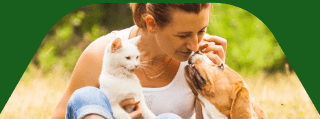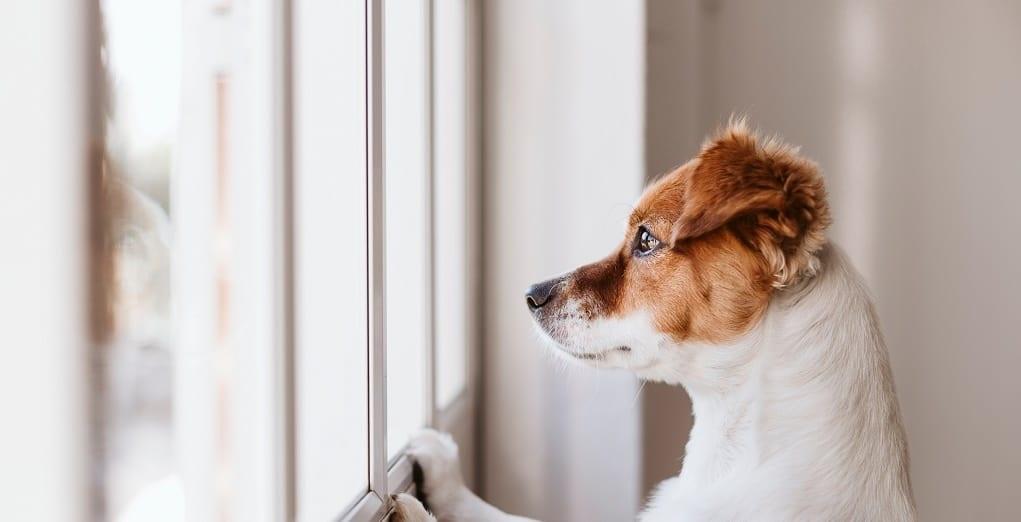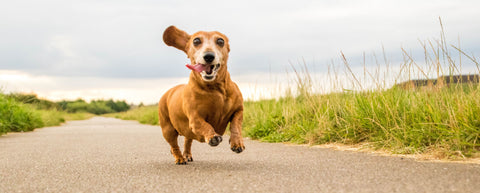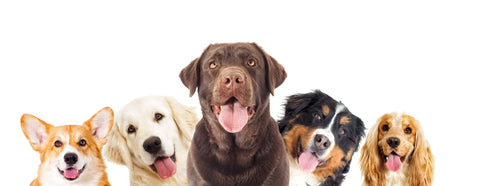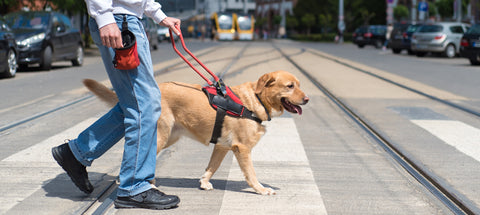Although the extra time with our canine companions during lockdown may feel like a bonus, many dogs are not used to us being at home 24/7, which could create a challenge for them when we need to go back to work and leave them without our company. Puppies growing up during lockdown may find separation from their humans challenging in future if the right support is not put in place.
In this blog, animal behaviourist and clinical behaviour scientist Helena Hale, focuses on how to support your dog or puppy in preparation for life after lockdown. We take a close look at the issue of separation anxiety: What is it and why does it happen? How can you recognise it? What can you do to prepare for life after lockdown? And how can you get support if your dog does show signs of anxiety when left alone?
What is separation anxiety?
Separation anxiety is the term used to describe dogs who show behavioural and physiological signs that they are distressed when parted from human company. Clinical behaviourists have found that up to 80%1 of our dogs sadly suffer in social isolation, where behavioural signs of distress can be less obvious, so the issue remains out of sight and out of mind. Untreated, separation anxiety can seriously compromise our dogs’ welfare regularly, and the problematic behaviours associated with it can undermine the dog-owner bond.
Why do dogs get separation anxiety?
Dogs are social animals, so spending time alone is not something that comes naturally to them. However, with a little support, dogs can learn that being by themselves is a normal and non-stressful part of life. The best time for teaching this is during the critical period for learning, often referred to as the ‘socialisation window’, when puppies are aged approximately 3-12 weeks. At this time, puppies’ brains are developing quickly, laying down the foundations about what life is all about, and how they fit into it. If puppies are not given the opportunity to learn that being by themselves can be a positive and normal part of life where they feel comfortable and relaxed, they can be susceptible to experience separation-related problems in future.
Some dogs display signs of separation anxiety later in life and there are different reasons for this, where all dogs and their circumstances are unique. However, changes in routine can trigger separation related behaviour problems which is why it is a good time to think about supporting your dog, in advance of life after lockdown.
How to recognise signs of separation anxiety
Dogs communicate how they are feeling through their body language, behaviour, and vocalisations. Physiological responses can also give us an idea about their emotional state. Below are some common signs that will help you to recognise separation anxiety.
More obvious signs of separation anxiety:
Destructive behaviour

If your dog chews up objects, or scratches/digs/chews at floors, walls or doors, when alone, this could be an indicator of separation anxiety – dogs do not do this to annoy their owners.
Toileting indoors

If you find signs of indoor toileting when you return but your dog is otherwise well house-trained, they could have been feeling distressed.
Barking, whining, or howling

Anxious dogs may vocalise when alone in an attempt to regain contact.
Less obvious signs of separation anxiety:
Restlessness

An anxious dog may struggle to settle and relax.
Trying to ‘escape’

Your dog might try to follow you out of the house, or scratch and dig at areas near where you left – these are signs they are trying to retain or regain contact.
Lack of appetite

Leaving treats or meals untouched can be a sign your dog is anxious without you around.
Shivering, shaking, or cowering

As you prepare to leave, or after you have gone, shivering, shaking, or adopting a cowering posture can signify your dog is anxious.
Top tips:
- Other signs of separation anxiety include trying to prevent you from leaving the house by blocking your exit or using attention-seeking or aggressive behaviour. Some dogs will make themselves scarce as you prepare to leave, to avoid the situation.
- If you are unsure how your dog responds to social isolation, set up a video camera to record their behaviour when you leave them.
- If the behaviour your dog displays when alone is not what they would normally do in company, it could be a sign of separation anxiety.
- Never punish your dog’s anxious behaviour as it will only add to their emotional distress.
- All dogs respond differently, and these behaviours can indicate problems other than separation anxiety.
What can you do to prepare for life after lockdown?
There are things you can do now to reinforce your dog or puppy in feeling confident and relaxed by themselves, for a smoother transition when lockdown lifts. Please note: these activities are preventative measures, appropriate for dogs who do not show signs of separation anxiety.
Top tips:
- Keep your dog’s routines similar to life before lockdown and what you will return to afterwards, with the same time of day for meals, exercise, comfort breaks, play and rest.
- Don’t be tempted to keep your dog by your side at all the time just because you like the company – give them unrestricted access to places where they can be alone so they don’t come to rely on you.
- Plan time apart, e.g. a trip to the store, time in different rooms or go out in the garden back yard whilst your dog is inside. Pair these times with something positive, such as a long lasting treat. Ensure your dog is comfortable alone by videoing them to see how they behave.
- If you are working at home, provide stimulation for your dog during your breaks and encourage them to settle when your attention is unavailable. You can do this by giving your dog something interesting and enriching in their bed, like a long-lasting treat. This can be in the same room as you if your dog finds it hard to settle elsewhere, and you can gradually increase the space between you, if your dog is comfortable to do so.
- Create a ‘safe space’ in a calm, quiet place. Here, provide independent activities that your dog enjoys, to reinforce them feeling good by themselves, such as puzzle-feeders, toys that they like playing with alone, or long-lasting treats.
- For puppies, do this whilst you are nearby, and gradually increase the distance so long as your puppy is still engaged with the activity – always return before they stop to make sure they keep feeling secure. If they show signs of distress, you are taking things too quickly!
How to get support if your dog has separation anxiety

If you think your dog is anxious when left alone, remember, you are not alone – separation anxiety is one of the most common dog behaviour problems and often goes undiagnosed and sadly, therefore, untreated. The good news is that it is treatable, and help is available for you and your dog to turn things around. Lockdown could provide the ideal time to get support for you and your dog in readiness for you going back into the big wide world!
Top tips:
- Minimise the time that your dog needs to spend by themselves, since repeatedly feeling anxious in isolation makes the problem worse, not better.
- If you see any of the signs that your dog has separation anxiety, such as toileting indoors or destructive behaviour, remember not to tell them off as this can deepen your dog’s distress and cause emotional conflict about their relationship with you.
- Ask your veterinarian to refer you to a Certificated Clinical Animal Behaviourist who will provide a full diagnosis and bespoke treatment for you and your dog.
- Treatment will include teaching your dog something new and positive about being alone, taking your individual dog’s emotional state, behavioural responses and living circumstances into account..
1https://behaviourvet.wordpress.com/2013/10/14/left-home-alone-a-welfare-issue-for-dogs/






